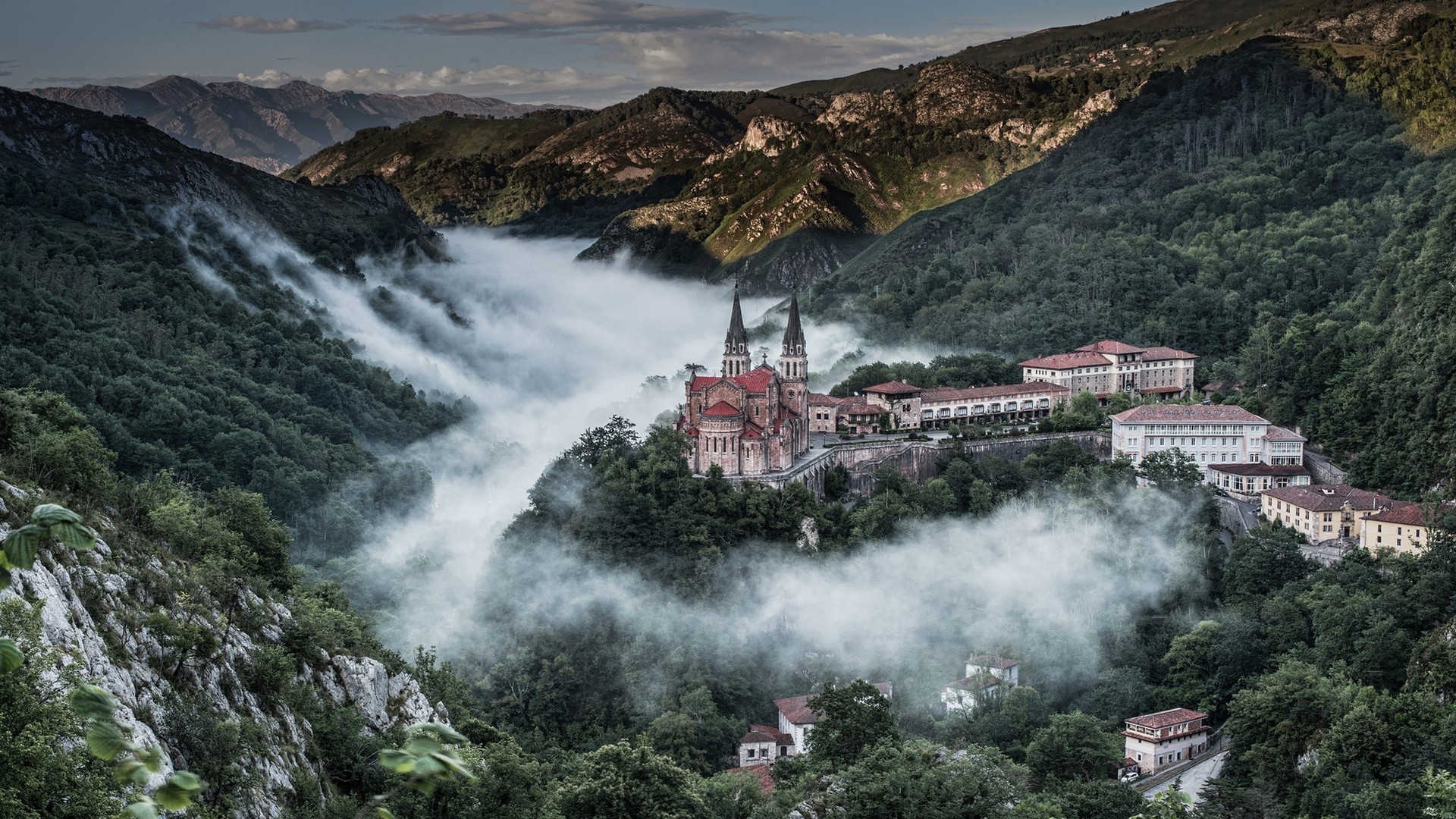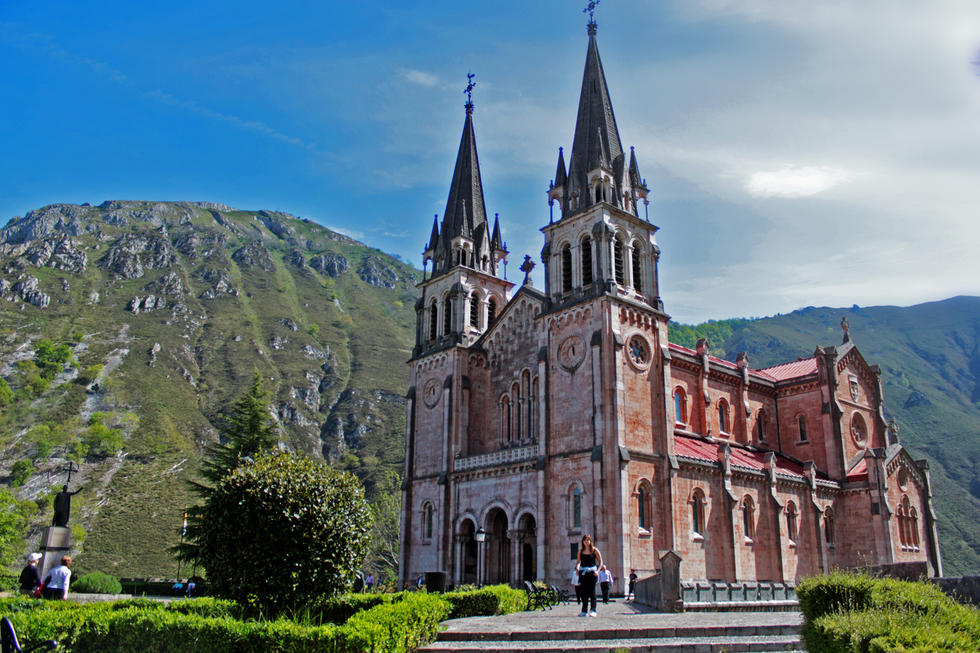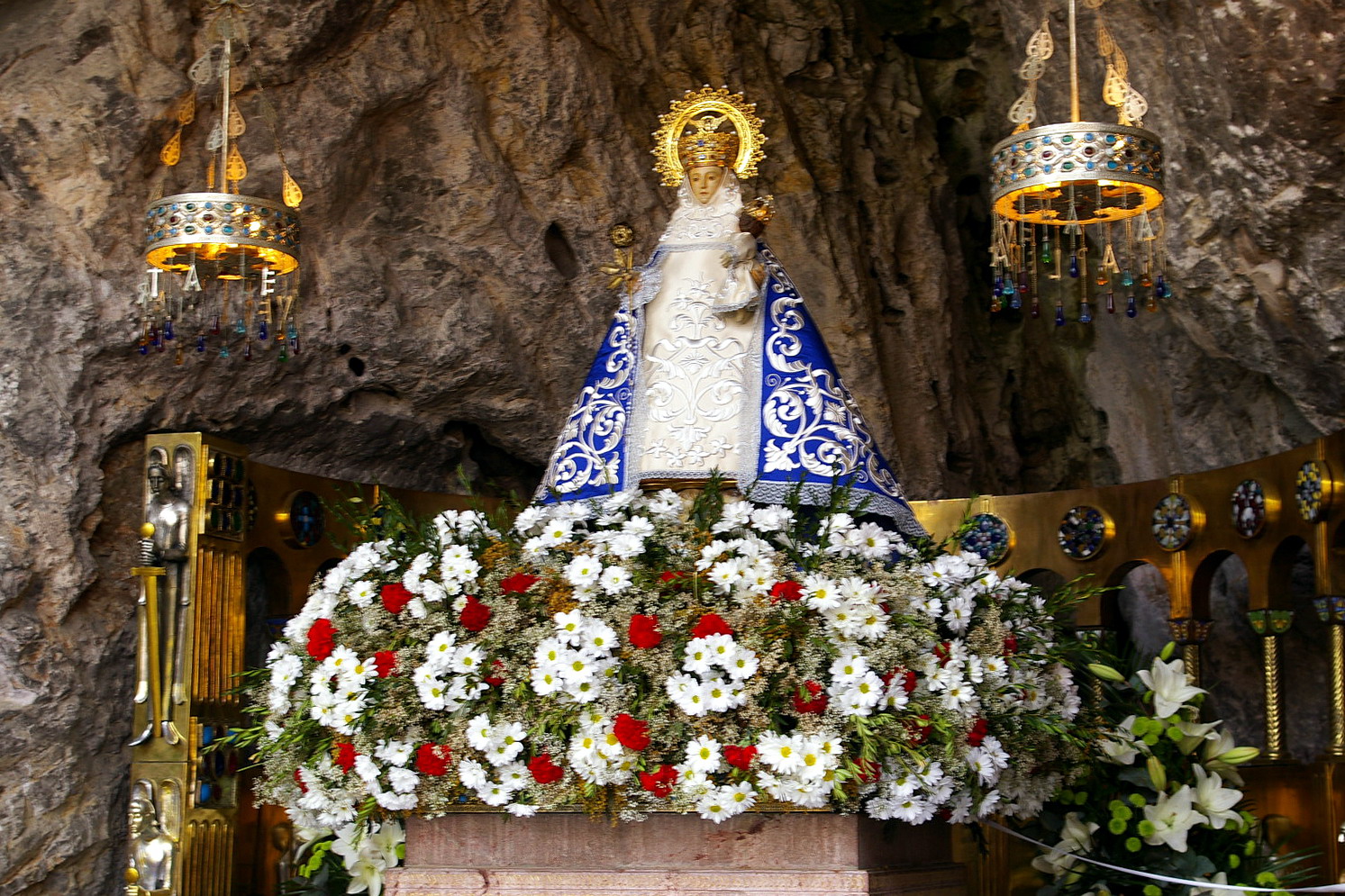The Basilica of Covadonga, alongside the sacred cave where pilgrims venerate the statue of La Santina (Our Lady), is a place of worship and pilgrimage for the people of Asturias. It is of neo-Romanesque style with two high towers flanking the main entrance. Nearby there is a spring which flows from the sacred cave and beneath there is a famous fountain with seven spouts and is a place of reference for all young ladies wanting to marry, a traditional local poem says: "The Virgin of Covadonga has a fountain very clear, the girl who drinks from it will marry within a year."

According to the legend King Pelayo and other Asturian warriors fought the Arabs from a cave dug out of one of the rocky faces of the Covadonga Valley. The tale says that a little virgin appeared to Pelayo in the cave before the battle forecasting the victory of the Christians over the Muslims. A different legend also tells that before the battle with the Muslims the cave was probably used, about 1500 years ago, as a celebration and worshiping centre by a Celtic sorceress and as a holy meeting place for the Celtic tribes that lived in the area at that time. This would be the earliest divine origin of the Covadonga cave, used in the first place by pagan Celtic tribes for magical and spiritual practices. As in many other locations throughout the region, with time, the Christians took over the holy Celtic spaces to build their own churches and sacred places, and Covadonga was not an exception.

A Christian chapel was the first construction inside the cave and it was ordered by King Alfonso I The Catholic (739-757) as a memorial for the battle of Covadonga. Originally the Holy Cave chapel was wooden, until it and everything it contained, including the image of the Virgin, jewels and goblets, were lost in the fire of 1777. The image, which is there today, dating from the 16th century, was donated by the Chapel of Oviedo Cathedral in 1778 as compensation for the loss of the early Virgin. The Virgin known as The "Santina" is an image of Mary which forms an integral part of the Asturian tradition through history, through word of mouth from generation to generation, and through personal religious experiences. Deeply rooted in the people of this land, it constitutes one of the strongest and most powerful convocational symbols that the Asturians have. Its figure was carved, incarnated, gilded and polychromed from oak in the 16th century. She measures 71.4cm tall, including the pedestal, with a girth of 46 cm at her widest point, and a depth of 21 cm. The current baby Jesus was placed there in 1704. Standing out from her clothing is the mantle that Our Lady wears from her shoulders to her feet. Its colour changes according to the occasion. The normal mantle is a reddish-purple colour with a golden trimming and stamped with simple floral motifs.

The chapel, which is to one side, was also reconstructed in stone, as it can be seen today. One can also find the tomb of Pelayo in the Cave, in front of the image of the Virgin.
Although he was originally buried in a nearby parish called Santa Eulalia de Abamia, his remains, along with those of his wife Gaudiosa and his sister, were later transferred to the Holy Cave where the tomb of Alfonso I and his wife Hermelinda (Pelayo"s daughter) is also kept, although slightly more hidden.
Behind the cave, in the guts of the mountain, an underground cascade runs free, and it reaches the outside world right underneath the cave, falling some 20 meters down into a natural water pool where pilgrims and visitors throw coins wishing for their dreams to come true.
After heavy rains or when the snow melts on the mountains the streams bulges with water and the sound of the waterfall is so intense that from inside the cave you can’t hear anything but the water crashing against the rocks and falling into the pool.
At one side of the pool you can find the seven-spout water fountain. Many Asturians still try to respect the tradition by going to Covadonga and drinking from all seven spouts before their marriage, just in case.
To access the cave there is a staircase leading up from the pool. It is not uncommon to see people going up the stairs on their knees because of a religious promise. The other way to access the cave is passing by the stone lions and following the road all the way up to the Basilica. Once at the Basilica there is a small pedestrian path that leads to a 30-metre tunnel carved out of the mountain and which is the antechamber of the Covadonga cave.
Silence and respect are demanded on the visit to the cave, especially when there is a mass on. It is a very similar atmosphere to Lourdes.
Many visitors from different regions and countries come every year to worship “la Santina”. Even Pope John Paul II made a very special visit to the Santina and to the Real Sitio of Covadonga in 1989, visiting also the Picos de Europa on his journey along the Camino de Santiago.
Roberto Frassinelli designed the basilica and the architect Federico Aparici Soriano erected it between 1877 and 1901. In 1777 a fire destroyed the old chapel that was by the Covadonga cave and it was then decided that they would build an eve more impressive structure. There was an initial project that was finally rejected because of its high costs and the opposition of local priests.
The definitive project was approved and launched by King Alfonso XII almost one century after the destruction of the original chapel. The initial project by Ventura Rodriguez with a classic design was finally replaced by the actual structure, which has a Romanesque style.
The original idea from the actual construction came from a German painter called Roberto Frassinelli, “el Alemán de Corao” that lived in the region. Architect Federico Aparici did the technical project, based on Frassinelli´s idea. The building sits over a large terrace and it has three different aisles. In the plaza in front of the basilica there is a 4 ton bell from 1900, a bronze statue of King Pelayo from 1964 and an obelisk from 1857, which according to the legend, stands at the place where King Pelayo was crowned.
The Covadonga Basilica was inaugurated on September 7th 1901, and Pope Leon XIII gave it the dignity of Basilica. It was built using pink limestone from the surrounding mountains. By the entrance portico there are two sculptures representing the two regional bishops started and finished the works. The inside of the basilica is famous because of its simplicity with just some decorative elements placed on the ceiling of the Basilica. Beside the high alter there are two large paintings of Madrazo and Carducho that represent the Battle of Covadonga and the proclamation of Pelayo as King of Asturias.
Beneath the high altar there is a "pit" with the relics of San Melchior and Pedro Poveda. To the left there is an altar dedicated to San Melchior, the only Asturian Saint, canonized by Pope John Paul II in 1989. Due to their economical contributions to the building of the basilica, flags from all South American countries are permanently shown.
Despite the many fires, the Museum of Covadonga still keeps very valuable and unique pieces. The crown of the Virgin of Covadonga is a very valuable piece of jewellery created by Felix Granda Buylla in 1918. It is made of gold with diamonds, rubies, sapphires and pearls. This crown is only used during the Covadonga celebration day, on September the 8th.
At the museum we can admire drawings from the basilica construction project done by the architect Ventura Rodriguez (the project that was rejected and replaced by the actual structure) as well as an impressive painting of King Pelayo. Pieces of jewellery, an ivory Christ from the XVI century donated by King Felipe II and ancient liturgical clothing together with other pieces of ancient art can also be contemplated and enjoyed within the museum. Nearby you will also be able to enjoy some of the most beautiful countryside Spain has to offer with breathtaking views of the Picos de Europa and some of the most beautiful lakes in Spain.
Ver mapa más grande
BEST TIME TO VISIT : ANY TIME OF YEAR